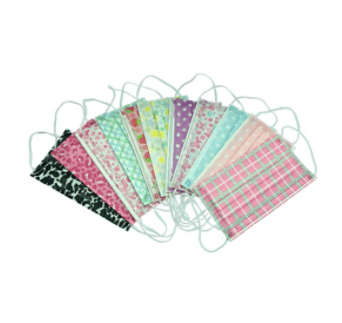Masks are so powerful and vital to our lives. What materials are used to make masks? Let us reveal the secret together today.
1.Pure cotton: used to make pure cotton masks, dense texture, good soft touch, and good air permeability, composed of two layers of cotton cloth at the front and back; pure cotton masks are mainly used for cold and warmth, it can avoid cold air directly irritating the respiratory tract , It can be washed and used many times; but pure cotton masks do not have the effects of dustproof, antibacterial, liquid resistance, etc., and cannot be used for purposes such as preventing the spread of germs.
2.Gauze: It is used to make gauze masks, which are made by overlapping medical gauze. This type of mask has no irritating odor, and these gauze masks have good air permeability, are safer and cleaner; and pure cotton masks The same does not have the effects of dustproof, antibacterial, liquid blocking, etc., and cannot be used for purposes such as preventing the spread of germs.
3.Activated carbon cloth: used to make activated carbon masks. The activated carbon material has strong adsorption capacity, effective antibacterial and dustproof, and is suitable for industrial dustproof and other industries.
4.Medical filament spunbond non-woven fabric: The polymer PP is heated and melted, drawn and spun, laid and hot rolled into a cloth. It is a kind of filament non-woven fabric and is a disposable medical and industrial mask. The surface layer material has the characteristics of good air permeability, low cost, and wide application. Most of them use point bonding, especially the surface bonding method. The surface bonding hot-rolled surface is relatively smooth, and the point bonding hot-rolling is relatively smooth. fluffy.

5.Medical staple fiber spunbond non-woven fabric: referred to as ES, is a composite fiber. After the ES fiber is heat-treated, the fiber and the fiber are connected to each other to form a non-woven fabric without a binder; generally, it is composed of hot rolling and non-woven fabrics. There are two types of hot-rolled, hot-rolled short fiber hot-rolled non-woven fabric, and non-hot-rolled hot-air non-woven fabric. The hot-air non-woven fabric has the effect of fluffy and breathable. The hot-rolled non-woven fabric has the same appearance as the spunbond non-woven fabric, but it has no advantages in terms of uniformity, feel, tensile strength and productivity. A small amount is used for disposable Face layer of medical mask.
6.Spunlace non-woven fabric: The spunlace process sprays high-pressure fine water onto one or more layers of fiber webs to entangle the fibers with each other, so that the webs can be reinforced and have a certain strength. The appearance of spunlace non-woven fabric is closer to traditional textiles, and it has the characteristics of high strength, low fuzz, high moisture absorption, fast moisture absorption, soft hand feeling, and good drape. Appearance patterns can be changeable, and the amount of disposable medical mask surface layer used for disposable medical masks has increased after printing in the past two years.
7.Needle-punched non-woven fabric (needle-punched cotton): Needle-punched non-woven fabric is a kind of dry-laid non-woven fabric. Needle-punched non-woven fabric uses the piercing effect of needles to reinforce the fluffy web into a cloth. Needle-punched nonwovens have good dimensional stability and elasticity, good permeability, and bulky products. It is mostly used for industrial protective masks such as N95 masks to reduce the barrier efficiency.
8.Melt-blown non-woven fabric (core material for masks): Melt-blown non-woven fabric is fabricated through polymer feeding, melt extrusion, fiber cooling, web formation, winding and other processes, and high-speed hot air is mainly used to spray holes on the die. The extruded polymer melt is drawn in a small stream to form ultra-fine fibers and condensed on the net curtain or drum, relying on self-bonding to become a non-woven fabric. The meltblown nonwoven fabric has good fiber web uniformity, soft hand feeling, excellent filtering and liquid blocking functions. Ordinary protective masks, medical masks, N95 masks and other medical treatments use melt-blown non-woven fabrics to block bacteria, body fluids, and dust.
Founded in 2006, Wellmien has grown to a company specializing in disposable medical supplies and Personal Protection Equipment (PPE), integrating with design, manufacture and sales capacity. Our sales headquarter is in Suzhou, Jiangsu and manufacturing plants cover a total area of 8,000m2 including 1,500m2 of clean room.
Wellmien provides globally medical care and food processing facilities with products including face masks, gowns, coveralls, aprons, bouffant caps, shoe covers, sleeve covers, under pads, disposable gloves, wound-care products, first-aid products and surgical packs etc. Our products are best sold to worldwide markets and widely applied to different settings such as hospitals, care centers, wholesalers, government agencies or institutes, food industries and households, etc. With excellent OEM services, our annual sales exceed 20 million USD.